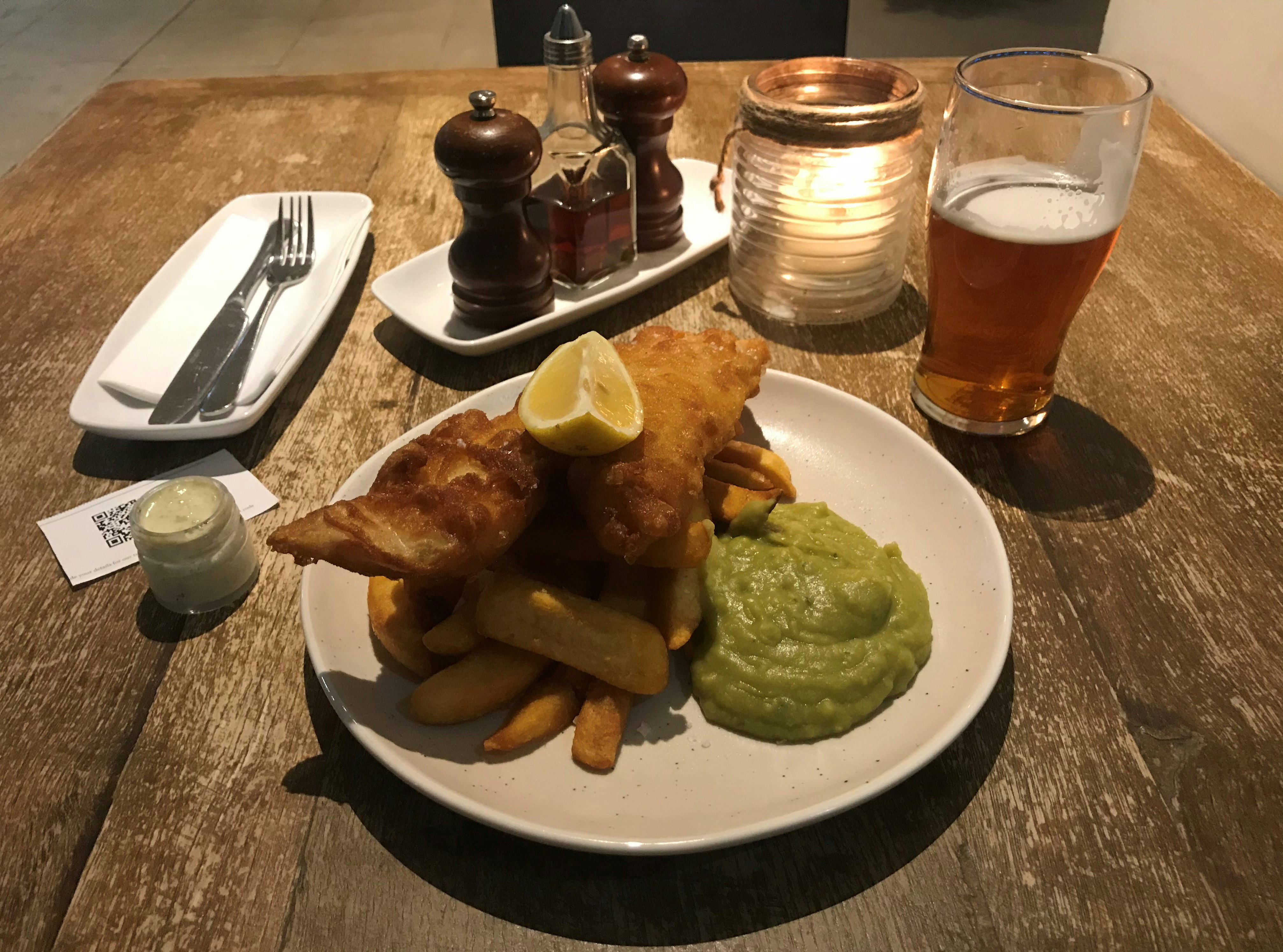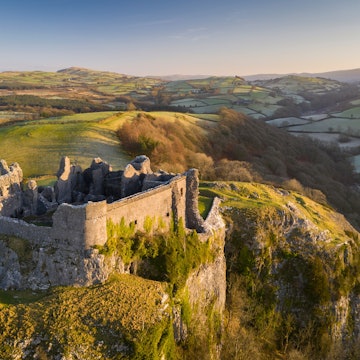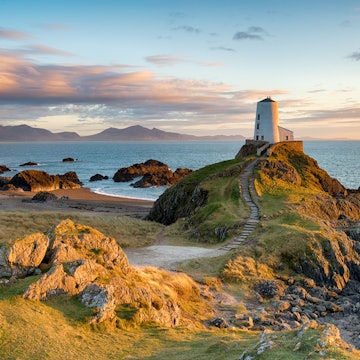
How to spend a weekend in Anglesey, the eco-friendly island loved by William and Kate

Jan 21, 2021 • 9 min read

William and Kate visit Newborough Beach, Anglesey © Samir Hussein / WireImage / Getty Images
The wild landscapes of North Wales are shroud in legend and myth, and, at times, the small island of Anglesey (or Ynys Môn in Welsh), cut adrift off Wales’ north-western tip, can take on an air of the fantastical.
Stories of unblemished natural splendor (almost of all Anglesey’s coastline is designated as an Area of Outstanding Natural Beauty), medieval castles (Unesco-listed Beaumaris to name one), and abodes of future kings and queens (The Duke and Duchess of Cambridge lived on the island during the first years of their marriage) may sound like the stuff of fairy tales, but the island's charms are very real. So too is its ambitious campaign to tackle plastic pollution.
Ready to uncover the highlights of a magical land that might not be so far, far away? Here’s our itinerary for the best things to do during a weekend in Anglesey.

Friday afternoon
Unless arriving by boat into Holyhead’s busy port, your first glimpse of Anglesey is likely to come from atop one of the two stoic bridges spanning the Menai Strait, a narrow but fierce funnel of water separating the island from the Welsh mainland.
Having crossed onto the island, stretch your legs and get a closer look at the colossal Menai Bridge (the world’s first iron suspension bridge) with a walk along the Belgian Promenade, which curves along the headland below the structure. This coastal walkway was built by Flemish refugees – who were accommodated on the island during WWI – as a show of gratitude to locals for the hospitality shown to them. The path runs along the strait from the gate of medieval St Tysilio’s Church, romantically set on its own forested island, to a particularly photographic boat house standing in the shadow of the grand bridge.

Friday evening
In 2019, Anglesey became the first county in the UK to be awarded Plastic Free Community status by marine conservation group Surfers Against Sewage (SAS) as a result of its campaign to minimize its reliance on single-use plastics. While this may serve as an additional draw to the island for tourists, Sian Sykes, Anglesey’s SAS rep – who has litter-picked on the island with the Duke and Duchess – is aware of the important part visitors have in aiding the island with its green ambitions.
“We want to inspire people by showing them what a greener society can look like,” says Sian. “But visitors also have a crucial role to play in supporting the good work we are doing to try and become plastic free.”
Alongside bringing reusable water bottles and bags to the island, one simple way in which travelers can aid the movement is by choosing to dine-in restaurants that have committed to cutting their reliance on single-use plastic, which are identifiable by a wooden plaque on their exteriors.
Dylan’s in the town of Menai Bridge is one such business, which has brought in a host of changes to limit its plastic use, including no longer providing straws or plastic stirrers and taking part in the island’s water bottle refill scheme. The restaurant also places an emphasis on serving up fresh local produce, typified by house speciality Menai Muscles; which come fresh from the strait overlooked by the restaurant’s glass-walled conservatory. Other delights on offer here include lamb hotpot, seafood chowder and butternut squash risotto.

Saturday morning
Start your first full day in Anglesey bright and early with a walk along one of its best beaches. Newborough Beach is a long, dune-backed stretch of white sand that dusts the island’s southwestern corner, with dramatic vistas of Snowdonia mountain range visible from across the strait. Visitors can pay to park at the Government-run beachside car park (£5) or take a 40 minute walk through forested trails to the beach from a number of free car parks around the village of Niwbwrch.
Once at the beach, stroll northwards to the slim finger of land jutting out into the strait, which becomes cut off from the mainland at very high tides. This unassuming grassy landmass is Llanddwyn Island (Ynys Llanddwyn), famed for its association with the legend of St Dwynwen, the Welsh patron saint of lovers. The story goes that Dwynwen accidentally turned a would-be suitor to ice by giving him the cold shoulder, only to stumble across an angel (sometimes a potion) in a forest who rather fortuitously offers to grant her three wishes. Firstly, Dwynwen asks for her scorned admirer to be thawed; then – having learned romance to be a dangerous game – wishes for all true lovers to find happiness; before, somewhat dramatically, requesting that she never marry, and instead spend her life as a hermit on Llanddwyn.

The fantastical tale led to the island becoming an extremely popular pilgrimage site for hopeful romantics in the 16th century, with a small chapel being consecrated in Dwynwen’s name. The weather-gnarled stone walls of the church remain today, as does the original doorway stone that’s been worn smooth from thousands of pilgrims crossing the threshold in the hope of one day finding lasting love.
Fittingly, given the area's association with fledgling romance, the beach was also a favorite spot of William and Kate, with the farmhouse they rented a short drive away. Even more recently, the sands here have become a popular location for beach cleans; but even if no organized picks are taking place during your visit you can still do your bit to help preserve the beach.
“It would be fantastic if visitors who go for a walk on the beach could pick up any plastic they might come across,” says Sian. “If you’re enjoying the beautiful coast we have here, then give some love back and help us protect it.”

Saturday afternoon
Having spent the morning marvelling at Anglesey’s pastoral charms, dedicate Saturday afternoon to seeking out some of the island’s impressive wildlife highlights.
Boat trips run year-round to Ynys Seiriol, better known by its moniker of Puffin Island. You’ll need to visit during breeding season (from May to July) to be in with a chance of spotting the photogenic, brightly-beaked seabirds, but, as a protected ecological site, the island is home to exciting avian life year-round, including cormorants, guillemots and razorbills. Seacoast Safaris and RibRide are among the operators offering tours.
For those not afraid of dipping a toe in the chilly Irish Sea, Anglesey Outdoors offers snorkel tours to get up close and personal with the island’s miscellany of marine life, including the occasional Atlantic grey seal, which are a common sight around the island. In a similar (but potentially warmer) vein, Psyched Paddleboarding offers paddle boarding tours around the Anglesey coast, with the chance of spotting seals, dolphins and porpoises.
If you prefer to do your wildlife viewing with feet firmly on dry land, then make a beeline for Llyn Parc Mawr Community Woodland, which has become a haven for British red squirrels. Pushed to the brink of extinction by their larger and more robust American grey cousins (who compete with them for food and territory), Anglesey is one of the few places in the UK to spy these emblematic copper-furred critters. Squirrels can be seen year-round but autumn is a good bet, with less foliage and the animals active throughout the day, gathering nuts before winter.

Saturday evening
After a busy day of sightseeing, it’s only right to spend the evening dining like a monarch. Located in the out-of-the-way village of Rhoscolyn (it seems privacy is paramount when you’re a royal), The White Eagle was a firm favorite with the Duke and Duchess of Cambridge during their time on the island.
According to the jovial landlord, the Duke would always opt for the fish and chips, consisting of light, flaking cod and thin, crisp batter, plus a hearty dollop of mushy peas; usually washing it down with a pint of local beer. While the Duchess tended to be less regimented in her eating habits, flitting between the venue’s selection of fresh seafood and salads. Dinner here is made even more pleasant thanks to the floor-to-ceiling bay window, offering views down towards Rhoscolyn Beach.

Sunday morning
Given Anglesey’s legion of celebrated seafood restaurants and cool artsy cafes, it might come as a surprise to learn that one of the island’s most highly-rated eateries is actually a burger van.
Recently relocated to its new scenic location near Holyhead Marina, ever-busy Pete’s Burger Bar rustles up bun-encased grub of the spill-out-into-your-lap variety, that can easily satiate the appetite of even the most rotund Welsh lorry driver – and in most cases provides change from a £5 note.
If you’re really hungry, opt for the evocatively titled Belly Buster – an overloaded bacon double cheese burger – and watch the fishing boats bob in the harbor while listening to Pete’s anecdotes about life on the island.
Hands still slightly sticky with sauce, point your satnav in the direction of South Stack Lighthouse, located a short drive away. The lonely white structure, built in 1809, stands atop a tiny rocky islet that marks the very north-western tip of Wales, and draws a steady stream of photographers who come to snap the tranquil maritime scene from the cliffs above. Puffins are also occasionally spotted here, as well as seals, basking on the surrounding rocks. You can drive right up to the cliffs above the lighthouse, but more enjoyable is to undertake the hour-long walk through the heather fields from the car park around the headland.

Sunday afternoon
No half-decent trip to Wales is complete without a visit to a castle, and Unesco-listed Beaumaris Castle (Castell Biwmares) is a beauty, even if it never quite lived up to expectations.
The castle was planned to be the last and the greatest royal stronghold built by Edward I, with four layers of defence and sixteen stone towers aligned in near-perfect symmetry. Unfortunately, due to a lack of funds (450 stone masons were employed to work on the project), Edward’s dream was never realized and the castle stands as an unfinished masterpiece of medieval engineering. That said, crossing the moat and circling the structure, atop the tall outer walls, is still certain to thrill history buffs and general castle enthusiasts alike.
If you’re feeling peckish ahead of your journey home, consider making a quick detour up the coast to teeny-tiny Lligwy Beach Cafe, the first business on the island to sign up to cut their plastic use. The cafe offers cakes, teas and coffees, as well as oven-baked pizzas, in an unbeatable setting overlooking a serene, sheltered bay.
Before departing the island, there’s one last essential thing to tick off the list: the Llanfairpwllgwyngyllgogerychwyrndrobwllllantysiliogogogoch station sign. The longest place name in the UK (which translates as Saint Mary’s Church in the hollow of the white hazel near a rapid whirlpool and the Church of Saint Tysilio of the red cave) was actually created as a very early example of a publicity stunt to bring people to the area – and still attracts selfie-snapping holidaymakers today. Well, when in Llanfairpwllgwyngyllgogerychwyrndrobwllllantysiliogogogoch...

Getting around
Anglesey is a relatively small island, measuring around 22 miles (35km) in length from north to south and roughly 25 miles (40km) from east to west. A private or rented car is the easiest way to get around (car rental companies on the island include Hertz and Enterprise). However, there is also a train line running from Llanfairpwllgwyngyll to Holyhead, as well as buses linking major towns.
You might also like:
10 great day hikes in WalesWhere William and Kate spent their family vacation
Best things to do in winter in Wales















